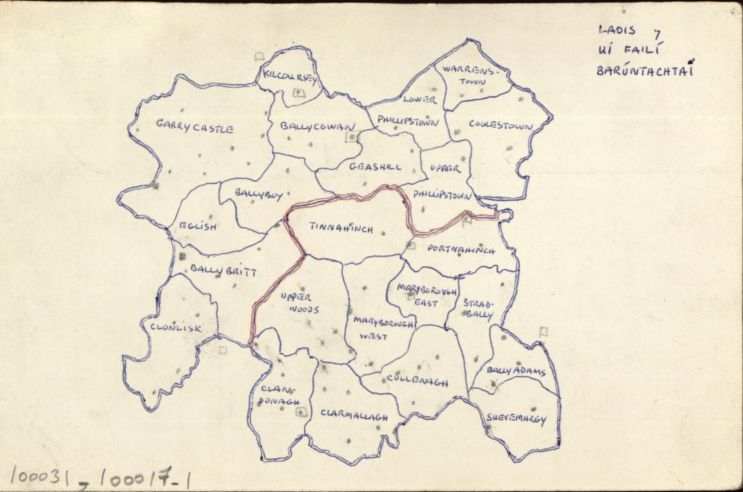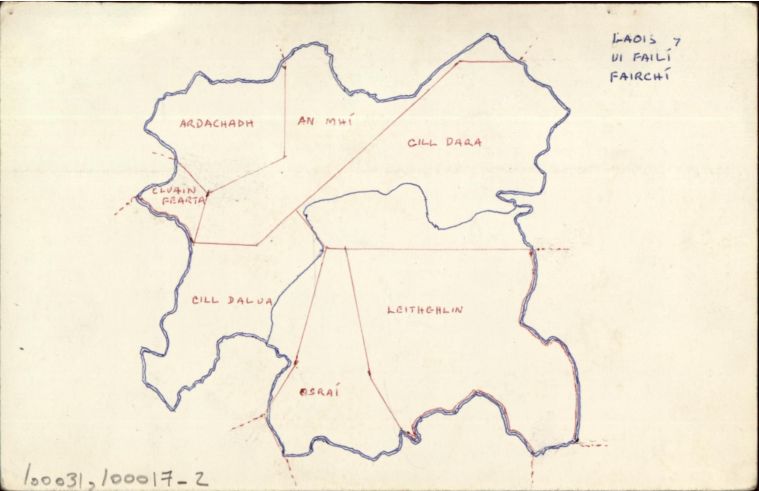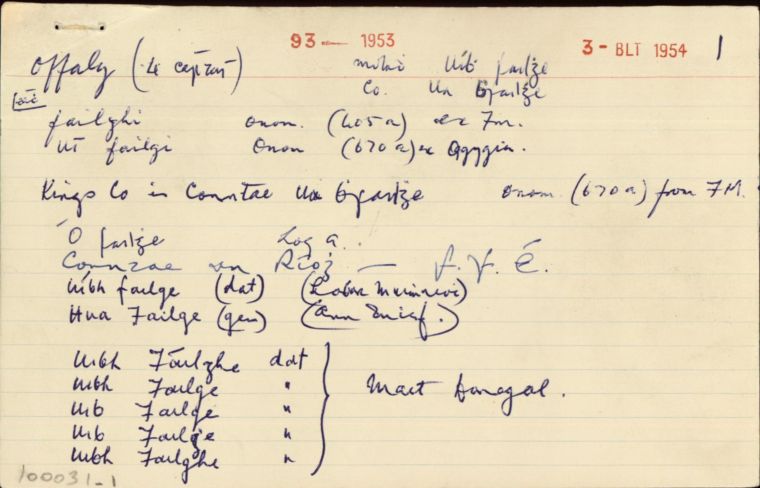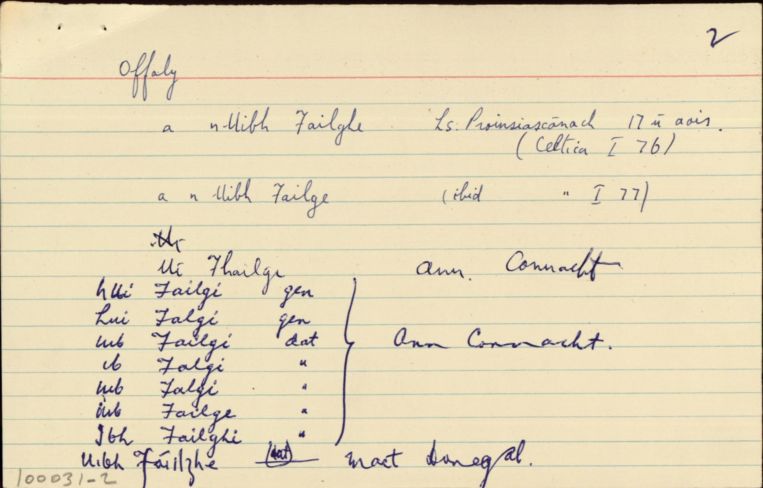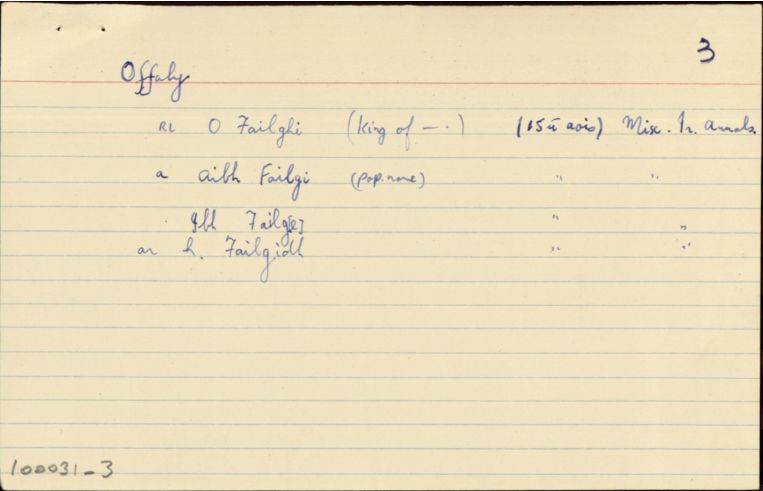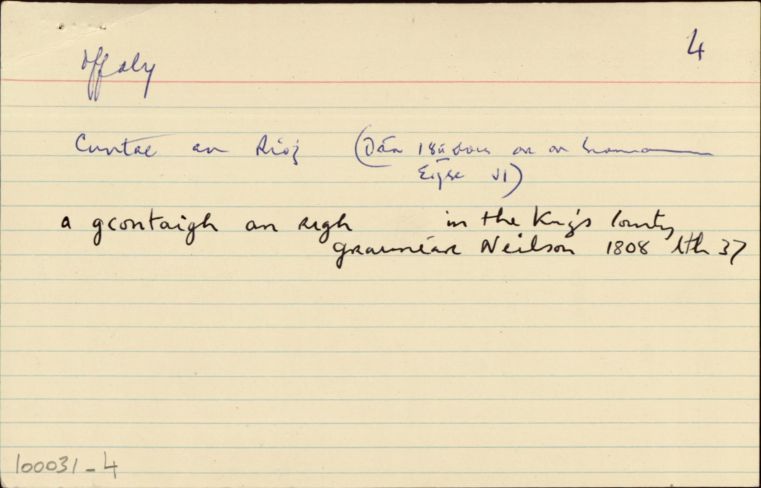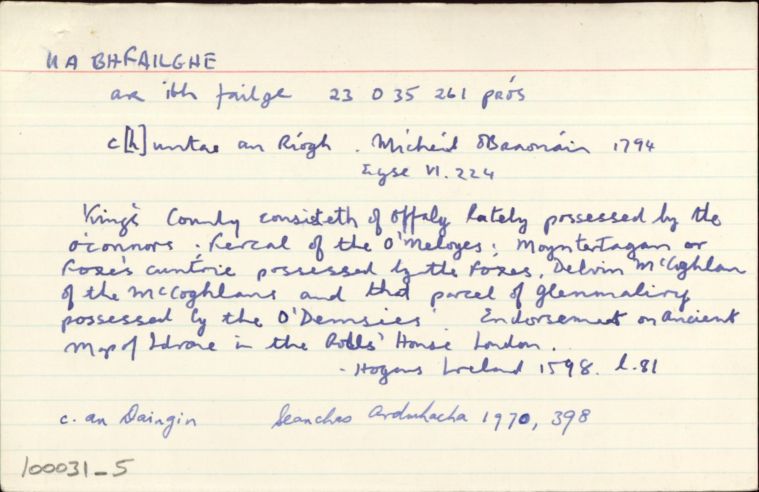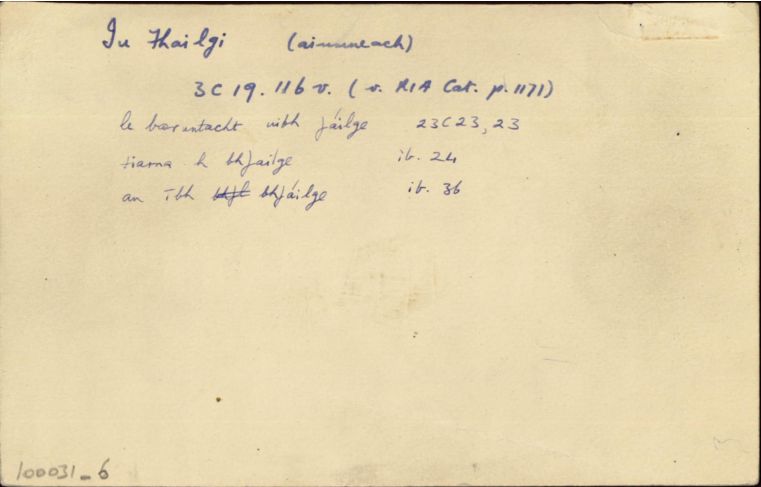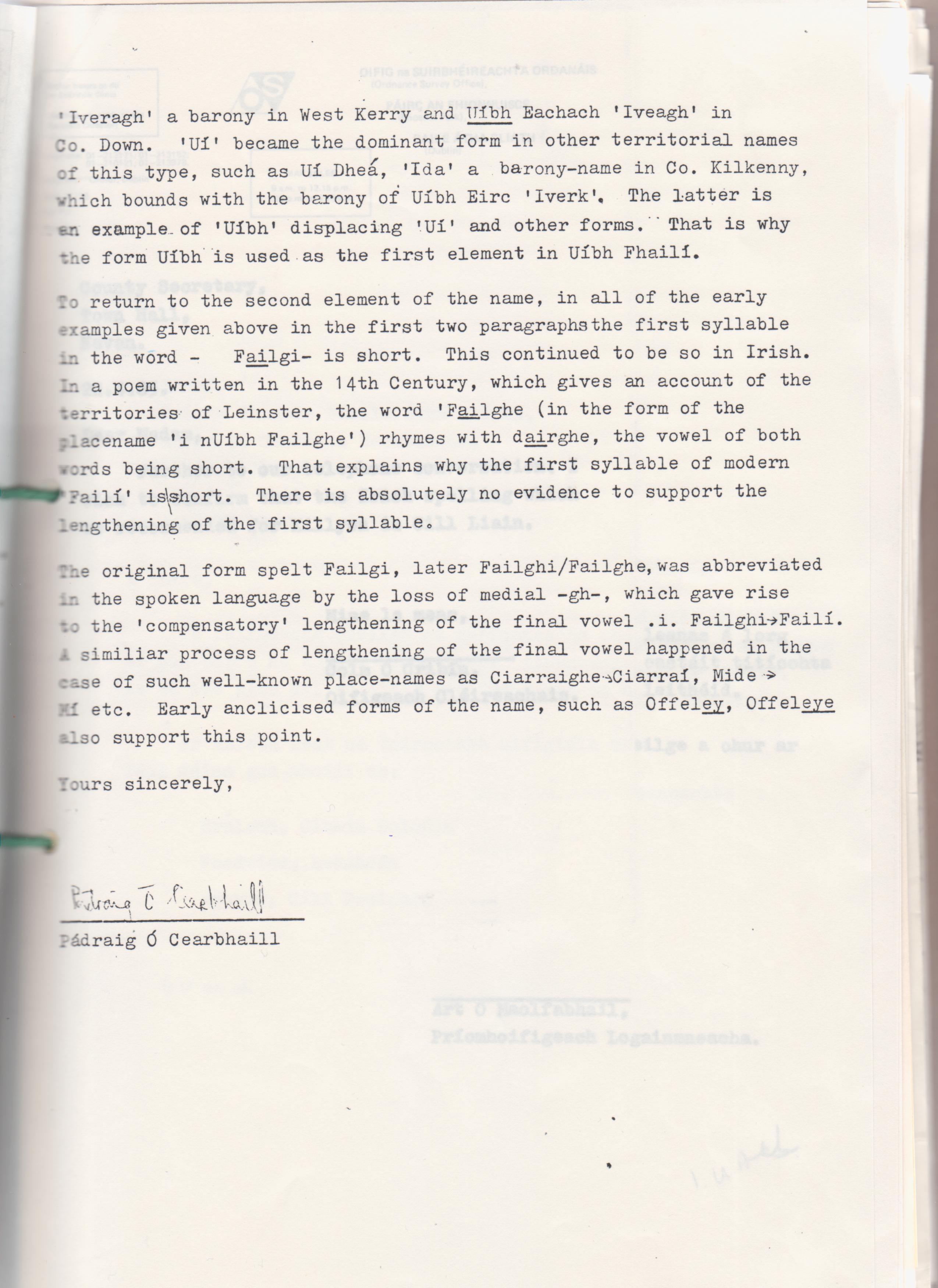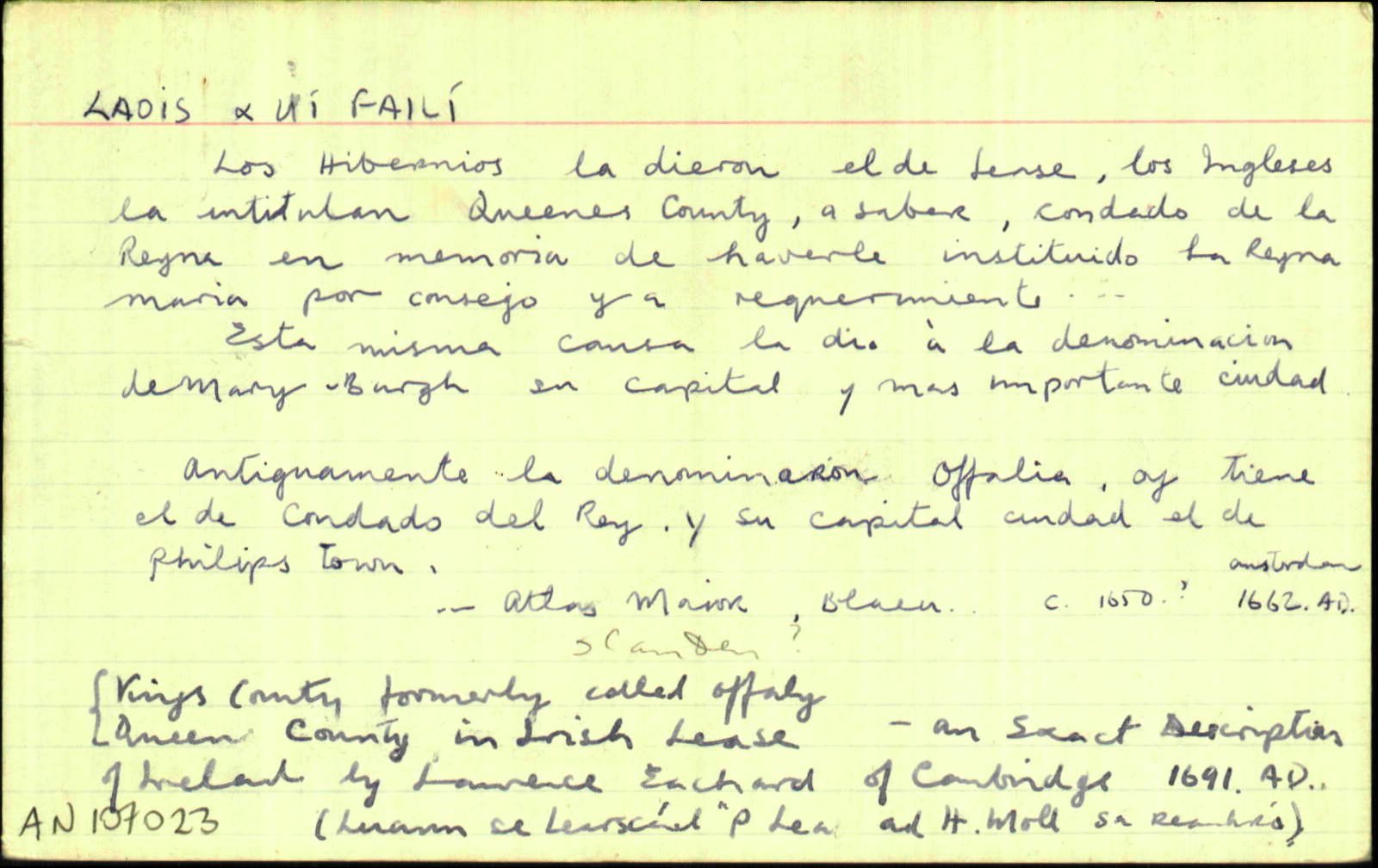Ordlathas
contae
fo-aonaid
Gluais
Nóta mínithe
- English
Uí Fhailghe, Uíbh Fhailí, etc. – the name of Offaly
Nollaig Ó MuraíleThe Irish name which, some eighty years ago, replaced the historical name of King’s County was a version of the ancient tribal name Uí Fhailge – in its anglicised form of Offaly. (That anglicised form had already been in use for some centuries as the name of a double barony in the west of Co. Kildare, from which the celebrated Silken Thomas Fitzgerald (d. 1537) took his title of Lord Offaly.)
The Uí Fhailge (to use a Middle Irish form of the name) were a people who are characterised in the medieval Irish genealogies as a branch of the Laigin, the people of Leinster, and are treated as one of the ‘Free Tribes’ of Leinster – by which is meant that they were exempt from paying tribute to the provincial overking. In the 6th century they had controlled the Liffey Plain (Mag Liphe) as kings of Leinster – their occupation of this region is reflected in the barony names aforementioned, Offaly East and Offaly West in Co. Kildare – and at an earlier stage they seem to have exercised overlordship of Mide, with their rule extending as far as Uisneach in Co. Westmeath, but their power diminished at the hands of the expanding Uí Néill dynasty early in the 6th century.
The Irish genealogies purport to trace the descent of the Uí Fhailge from one Rus Failgech, or Rus Failge, who is said to have been a son of Cathaer Már, the ancestor deity of the Laigin – according to a Middle Irish poem preserved in the 12th-century Book of Leinster, Rus was one of triplets born to Cathaír by the goddess Medb. However, as that great scholar, Thomas F. O’Rahilly, pointed out, almost sixty years ago (Early Irish History and Mythology, p. 19),
the descent of the Uí Fhailge from Rus Failgech, son of Cathaer Már, is a genealogical fiction. Actually, they take their name from Failge Berraide, who lived in the early sixth century. In 510 he won a battle at Frémainn Mide [Frewin Hill, a few miles northwest of Mullingar, Co. Weatmeath].
The 9th-century Tripartite Life of St Patrick refers to Failge, making him a contemporary of St Patrick. In fact, it divides him into two persons: Foilgi Berraidi, who dies after allegedly attempting to murder the saint, and Foilgi Ross, ‘whom the saint blessed and from whom the rulers of the Uí Fhailge descend.’ (Failge Ross, later Failge Rot, was later still transformed into Rus Failge, or Failgech.) As to the meaning of the name, this is unknown – in Old Irish failgi existed as a plural of the word fail, meaning ‘a ring, arm-band or bracelet,’ but there is no reason to believe that the name in question here has any connection with that.
The tribal name Uí Fhailge means literally ‘the descendants of Failge’ – Uí is the nominative plural of Ó (earlier Ua), a word meaning ‘grandson of’, and later ‘descendant of’, and which of course is now one of two surname markers used in native Irish nomenclature (the other being Mac).
Note on the name-form
The oldest Irish form of the name is Aui Foilgi, the standard Old Irish form Uí Falgi, the Middle Irish Uí Fhailge, and the early Modern/Classical Irish form is Uí Fhailghe.
In current Irish orthography, there is a tendency to render medial -gh- as í (see placenames such as Derrygonnelly, Doire Ó gConaíle, Co. Fermanagh, or the Mayo surname Ó Murghaile, now rendered Ó Muraíle), so the regular spelling of the second element in the name being considered here should be Failí.
The anglicised name-form Offaly, however, does not come directly from Uí Fhailí, but rather from an oblique form of the name, namely from the old genitive, as in barúntacht, or contae, Ua bhFailghe (in modern spelling Ó bhFailí) – which means ‘the barony, or county, of the Uí Fhailghe.’ That form would be pronounced approximately Oo-fālly (with stress on the second syllable).
The Irish form in regular use for the past forty years represents a petrified dative or locative form Uíbh Fhailí – ‘petrified’ is a technical term that means that the form cited does not change any more according to case. (Strictly speaking, the rather more correct form would be Uíbh Failí, since Uíbh was not usually followed by lenition.) There are other Irish place-names with a similar structure, e.g. that of the Iveragh peninsula (and barony) in south-west Co. Kerry (Uíbh Ráthach), the barony of Iveagh, Co. Down (Uíbh Eachach), the barony of Iverk, Co. Kilkenny (Uíbh Eirc), the territory of Iveleary in the barony of Muskerry in West Cork (Uíbh Laoghaire), a parish called Iveruss in Co. Limerick (Uíbh Rosa), or a townland called Evegallahoo in the same county (Uíbh Gallchú – earlier Uíbh Gallchubhair).
It may be worth repeating here that there is virtually no evidence that the ‘a’ in the second element of the name was ever long – therefore the form often heard from the lips of Irish speakers, Uíbh Fháilí, or Uí Fáilí, or Ua Fáilí, must be deemed to be wrong. (I say ‘virtually’ because there is at least one instance with a long ‘a’ in a 17th-century manuscript; although this is quite exceptional, it was followed – quite surprisingly – by the scholarly Fr Paul Walsh.)
In conclusion, it should be mentioned that the change of name from King’s County (deriving from Philip II of Spain, consort of Queen Mary Tudor) was opposed by some Irish scholars, most notably Paul Walsh and T.F. O’Rahilly, whose nationalist credentials could not be disputed. Fr Walsh expressed his views quite trenchantly in an article, ‘Origin of the King’s County and Uí Fhailghe’, originally published the Irish Book Lover 26 (1938), 50-6, and later reprinted, as ‘The origin of King’s County,’ in Irish Chiefs and Leaders (1960), pp 270-80. Among his comments are the following:
Before the advent of the reformers of 1920 King’s County contained twelve baronies, and was almost four times greater in size than the old country of Uí Fáilghe* [sic] *or Offaly. .... So the reformers of 1920 were guilty of an uncalled-for blunder .... [since] a considerable portion of the ancient kingdom of the O Connors is not included in the present county of Offaly at all. .... It would have been logical to abolish the counties altogether, and with them their names, whatever they were. But the sensible thing to do, seeing that the counties were not to be abolished, would have been to leave the name as it was.
Two steps might then be taken: (1) let the zealous Councillors learn the Irish language; and (2) let them christen the county Conndae an Ríogh .... They would have good authority for doing this. Brother Michael O Clery, the chief of the Four Masters, knew more Irish than all the Councillors, and all the University graduates, and all the amateur archaeologists in Ireland put together. He wrote .... Conndae an Ríogh. .... Nobody pronounces Offaly correctly. The universal utterance of the name sounds like the English word ‘Awfully’ – which in a way is not inappropriate, as the designation is a monstrosity. .... When the word was introduced into English, it was accented on the second syllable, not on the first. .... [A] much more common spelling of Offaly was Affalie, or some variant of that. But the earliest and best English writing of the word was Iphaly. The latter is the basis of Philip O Sullevan Béara’s Iphalia . . . If such a thing were needed, this variation of spelling is sufficient to make the present pronunciation ‘Awfully’ ridiculous. And up to ridicule the name and the pronunciation of it, as well as those responsible for the continuance of both, should be held.
(Irish Chiefs and Leaders, 271, 279-80.)To recapitulate, then, there is no justification for the pronunciation one sometimes hears of the Irish form of the county’s name as (approximately) ‘Oo-faully’. The vowel, ‘a’, in the first syllable of the name’s second element has almost invariably been shown as short, and therefore the correct pronunciation is closer to ‘Eve-olly’, with stress on the second syllable (‘oll’) – and not forgetting that the ‘l’ is slender! Therefore, the correct Modern Irish form is not Ua Fáilí (or the like), but rather Uíbh Fhailí.
Lárphointe
Tagairtí stairiúla
| 1450 c |
Hí Fhailghi
|
Ir. Bard. Poet Leathanach: 155, Líne: 35, Véarsa:
|
| 1600c |
Ophaly, now called the Kinges countye
|
|
| 1603 |
King’s County alias Offaly ...
|
|
| 1725c |
(co.) an Righ ... (rí-phort) Daingean Ibh Falge
|
Aire: Cáipéisíocht áirithe chartlainne de chuid an Bhrainse Logainmneacha í seo. Léirítear anseo cuid de réimse thaighde an Bhrainse Logainmneacha ar an logainm seo thar na blianta. D'fhéadfadh sé nach taifead iomlán é agus nach bhfuil aon rangú in ord bailíochta déanta ar an bhfianaise atá ann. Is ar an tuiscint seo atá an t-ábhar seo á chur ar fáil don phobal.
Is féidir leas a bhaint as an ábhar cartlainne agus taighde atá curtha ar fáil ar an suíomh seo ach an fhoinse a admháil. Ní mór scríobh chuig logainm@dcu.ie chun cead athfhoilsithe nó saincheisteanna eile maidir le ceadanna nó cóipcheart a phlé.
Nasc buan
https://www.logainm.ie/100031.aspxSonraí oscailte
Comhéadan feidhmchláir (API)
Linked Logainm
Formáidí: RDF | RDF N3 | RDF JSON | RDF XML

